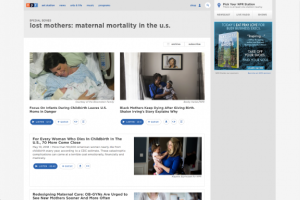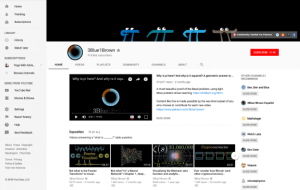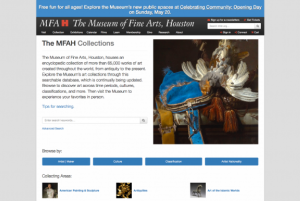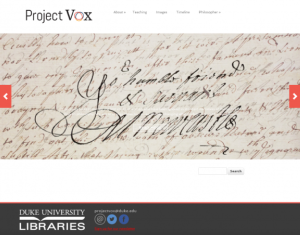Research and Education
Back to Top
|
 |
|
Native Knowledge 360
|
Social studies |
|
Native Knowledge 360 (NK360) is a project of the Smithsonian Institution's National Museum of the American Indian designed to "inspire and promote the improvement of teaching and learning about American Indians." On the NK360 website, K-12 educators will find a wealth of resources that can be implemented in the classroom. Instructors may want to start by exploring the NMAI's Essential Understandings about American Indians, which are based on the National Council for the Social Studies' national curriculum standards and are intended to guide classroom instruction. Collectively, these essential understandings outline "key concepts about the rich and diverse cultures, histories, and contemporary lives of Native peoples." The Lessons & Resources page contains digital lesson plans, posters, teacher's guides, and other resources for the classroom. Instructors can browse these resources by subject (including art education, social studies, and STEM), grade level, or language (English or Spanish). Teachers may also browse by nation or region. Perhaps a highlight of this collection are the digital lessons, which engage high-school students with essential questions such as "Is a treaty intended to be forever?" and "What kinds of actions can lead to justice?" [MMB] |
|





|
|
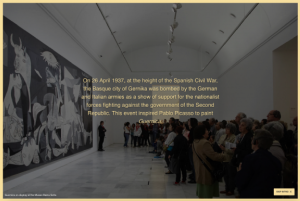 |
|
Rethinking Guernica
|
Arts |
|
Pablo Picasso's mural Guernica depicts a single horrific event: the April 1937 bombing of the Basque city of Gernika by Nazi Germany and fascist Italy, who were allied with nationalist Francisco Franco during Spain's Civil War. Today, the iconic painting is held by the Museo Reina in Madrid, Spain. The Reina Sofia recently published Rethinking Guernica, a powerful online exhibit about the history and significance of this painting. This exhibit incorporates 2,000 documents, which includes photographs, letters, newspaper clippings, manuscripts, and posters. Visitors may explore these documents in the stories section, where they are arranged by categories such as "artistic debate" and "borderless geography." The latter category documents the many locations where Guernica was displayed throughout the twentieth century. Alternatively, visitors may explore these documents by learning about key individuals (referred to as agents) connected to the paintings or chronologically. [MMB] |
|





|
|
 |
|
Harry Ransom Center Digital Collections: Gabriel Garcia Marquez
|
Language Arts |
|
The Harry Ransom Center at the University of Texas at Austin is home to the archives of novelist Gabriel Garcia Marquez. This archival collection includes ten book manuscripts, 40 photo albums, and over 2,000 pieces of correspondence. Interested readers from around the world can explore almost 400 digitized items from this collection on the Ransom Center's website. Visitors can explore the digital collection by selecting the browse link. From here, researchers can conduct a keyword search or explore the digital collection by date, creator, format (e.g. manuscripts, color photographs) genre (e.g. fiction, journalism, novellas), or subject. A few highlights of this collection include: images from a 1966 manuscript of Cien Anos de Soledad (One Hundred Years of Solitude), a 1929 photograph of Garcia Marquez as a child, and a copy of the author's 1982 speech "La Soledad de America Latina" (The Solitude of Latin America). [MMB] |
|





|
|
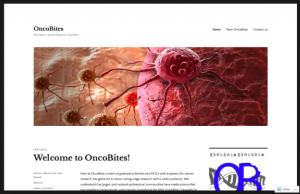 |
|
 |
|
Northeastern University: Boston's Latino/a Community History
|
Social studies |
|
From Northeastern University's University Archives and Special Collections comes Boston's Latino/a Community History: a collection of over 8,000 digitized items from two organizations. These include Inquillinos Boricuas en Accion, a tenants' rights and community development organization founded in 1967; and La Alianza Hispana, a civil rights organization founded in 1968 by educator Ana Maria Rodriguez. These digitized items include photographs, meeting minutes, newsletters, reports, and more. Visitors unfamiliar with these two organizations may want to start by reading the project section, which provides a short history of Inquillinos Boricuas en Accion and La Alianza Hispana. From here, visitors can conduct a search or browse the collection from the homepage. This collection can be browsed by creator, year, or subject (e.g. housing rehabilitation, community centers, Hispanic-American children). This rich collection may especially appeal to researchers interested in Latinx history, urban history, and the history of community organizing. [MMB] |
|





|
|
 |
|
The Physics Classroom: Concept Builders
|
Science |
|
The well-renowned Physics Classroom website (see the 11-12-2004 Scout Report) recently introduced Concept Builders, a series of interactive tutorials designed to help students understand and apply physics concepts. As of this write-up, the collection features thirteen concept builders, which address topics including Newton's Law of Motion, circular motion and gravitation, electric circuits, and waves and colors. When visitors select one of these concept builders, they will view a series of short tutorials related to the concept. Each tutorial is accompanied by a learning goal, which allows learners and instructors to locate relevant tutorials with ease. To participate in each tutorial, visitors simply need to select "Launch Concept Builder." Next, visitors are prompted to select a level ("apprentice," "master," or "wizard"). Based on their selection, visitors will view six practice problems related to the tutorial's learning goal. Each of these interactive tutorials is accompanied by a helpful set of teacher's notes and suggestions for instructors interested in incorporating Concept Builders into their curriculum. [MMB] |
|





|
|
 |
|
Origins: Current Events in Historical Perspective
|
Social studies |
|
From the history departments of The Ohio State University and Miami University in Oxford, Ohio comes Origins: Current Events in Historical Perspective, a collection of resources designed to put current events in historical perspective. This website was launched in 2007 and currently consists of several components. In the milestones section, readers will find essays that discuss significant historical anniversaries. These essays are authored by OSU and Miami University faculty. For instance, in an April 2018 essay, Dr. Hasan Kwame Jeffries writes about the fiftieth anniversary of Dr. Martin Luther King's assassination. History Talk is a podcast hosted by OSU history Ph.D. candidates Jessica Vinas-Nelson and Brenna Miller that addresses contemporary issues from a historical perspective. In the connecting history section, readers will find information about "the newest blogs and coolest links to historical stuff across the web," including podcasts, video games, and more. This section also contains shorter essays from faculty and graduate scholars that address the connections between history and current events. Those looking for further reading will find book reviews in the hot off the press section. Finally, educators will find lesson plans designed to help students see the connections between history and current events by navigating to teacher tools. [MMB] |
|





|
|
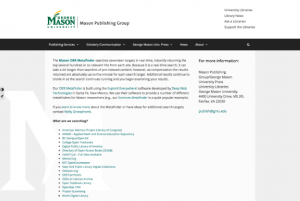 |
|
Mason OER Metafinder
|
Science |
|
The Mason OER Metafinder from The Mason Publishing Group at George Mason University Libraries is a powerful search tool that allows users to search record metadata from seventeen digital libraries and repositories, including the Digital Public Library of America, OER Commons, and AMSER-Applied Math and Science Education Repository. Searches are conducted in real-time and are not pre-indexed. To get to the actual metafinder, visitors should click on Mason OER Metafinder from the homepage. The metafinder allows users to enter search terms in full record (allowing users to search across the entire content of a document), title, author, or date range. Users can also choose which sources the metafinder should search by unselecting repositories below the search bars (all repositories are included by default). As an example, by searching for San Francisco in the full record search bar, the top 755 results are displayed from over a million sources retrieved. The option to narrow down results is available on the left-hand side of the search results. The Mason Publishing Group also offers a companion Sciences Metafinder, also available from their homepage, which specifically searches scientific repositories for science resources. [JLB] |
|





|
|











